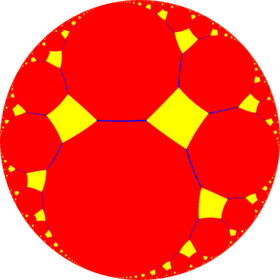Order-4 hexagonal tiling honeycomb
| Order-4 hexagonal tiling honeycomb | |
|---|---|
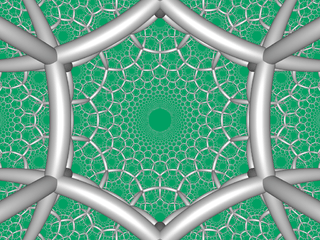 Perspective projection view within Poincaré disk model | |
| Type | Hyperbolic regular honeycomb Paracompact uniform honeycomb |
| Schläfli symbols | {6,3,4} {6,31,1} t0,1{(3,6)2} |
| Coxeter diagrams |  ↔ ↔ |
| Cells | {6,3} |
| Faces | hexagon {6} |
| Edge figure | square {4} |
| Vertex figure |  octahedron, {3,4} |
| Dual | Order-6 cubic honeycomb |
| Coxeter groups | BV3, [6,3,4] DV3, [6,31,1] [(6,3)[2]] |
| Properties | Regular, quasiregular honeycomb |
In the field of hyperbolic geometry, the order-4 hexagonal tiling honeycomb arises as one of 11 regular paracompact honeycombs in 3-dimensional hyperbolic space. It is called paracompact because it has infinite cells. Each cell consists of a hexagonal tiling whose vertices lie on a horosphere: a flat plane in hyperbolic space that approaches a single ideal point at infinity.
A geometric honeycomb is a space-filling of polyhedral or higher-dimensional cells, so that there are no gaps. It is an example of the more general mathematical tiling or tessellation in any number of dimensions.
Honeycombs are usually constructed in ordinary Euclidean ("flat") space, like the convex uniform honeycombs. They may also be constructed in non-Euclidean spaces, such as hyperbolic uniform honeycombs. Any finite uniform polytope can be projected to its circumsphere to form a uniform honeycomb in spherical space.
The Schläfli symbol of the order-4 hexagonal tiling honeycomb is {6,3,4}. Since that of the hexagonal tiling of the plane is {6,3}, this honeycomb has four such hexagonal tilings meeting at each edge. Since the Schläfli symbol of the octahedron is {3,4}, the vertex figure of this honeycomb is an octahedron. Thus, 8 hexagonal tilings meet at each vertex of this honeycomb, and the six edges meeting at each vertex lie along three orthogonal axes.[1]
Images
 Perspective projection | |
 The vertices of a t{(3,∞,3)}, |
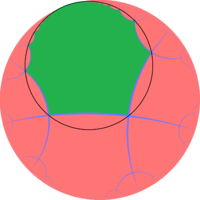 It is analogous to the H2 order-4 apeirogonal tiling, {∞,4}, shown here with one green apeirogon outlined by its horocycle |
Symmetry

It has three reflective simplex symmetry construction. The uniform construction {6,31,1} has two types (colors) of hexagonal tilings in the Wythoff construction. ![]()
![]()
![]()
![]()
![]()
![]()
![]() ↔
↔ ![]()
![]()
![]()
![]()
![]() A quarter symmetry construction can have four colors of hexagonal tilings:
A quarter symmetry construction can have four colors of hexagonal tilings: ![]()
![]()
![]()
![]()
![]() .
.
An additional two reflective symmetries exist with nonsimplex fundamental domains:Coxeter notation: [6,3*,4], index 6, ![]()
![]()
![]()
![]()
![]()
![]()
![]() , and [6,(3,4)*], index 48, with a cube fundamental domain, and octahedral Coxeter diagram with three axial infinite branches:
, and [6,(3,4)*], index 48, with a cube fundamental domain, and octahedral Coxeter diagram with three axial infinite branches:  . It can be seen with 8 colors of hexagonal tilings.
. It can be seen with 8 colors of hexagonal tilings.
This honeycomb contains ![]()
![]()
![]()
![]()
![]() that tile 2-hypercycle surfaces, similar to this paracompact tilings,
that tile 2-hypercycle surfaces, similar to this paracompact tilings, ![]()
![]()
![]()
![]()
![]() :
:
Related polytopes and honeycombs
It is one of 15 regular hyperbolic honeycombs in 3-space, 11 of which like this one are paracompact, with infinite cells or vertex figures.
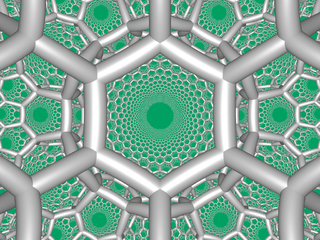 {6,3,3} |
 {6,3,4} |
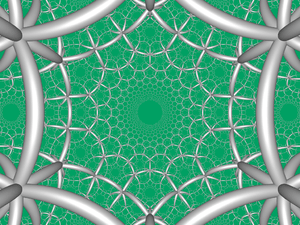 {6,3,5} |
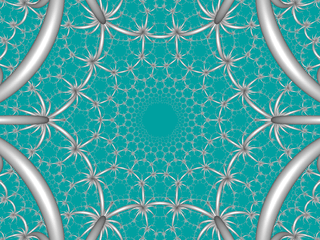 {6,3,6} |
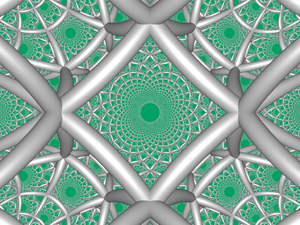 {4,4,3} |
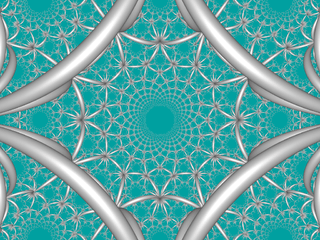 {4,4,4} |
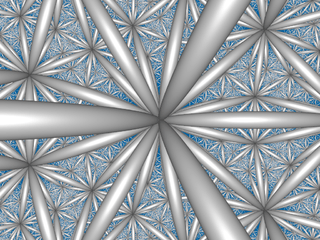 {3,3,6} |
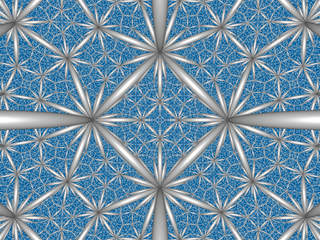 {4,3,6} |
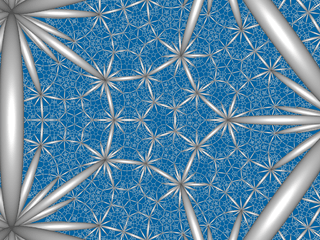 {5,3,6} |
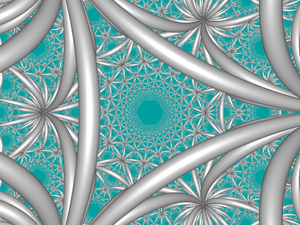 {3,6,3} |
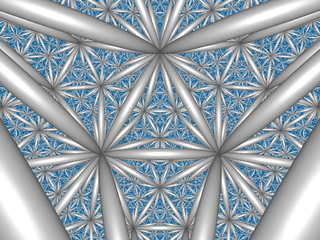 {3,4,4} |
There are fifteen uniform honeycombs in the [6,3,4] Coxeter group family, including this regular form, and its dual, the order-6 cubic honeycomb, {4,3,6}.
| {6,3,4} | t1{6,3,4} | t0,1{6,3,4} | t0,2{6,3,4} | t0,3{6,3,4} | t0,1,2{6,3,4} | t0,1,3{6,3,4} | t0,1,2,3{6,3,4} |
|---|---|---|---|---|---|---|---|
 |
 |
||||||
 |
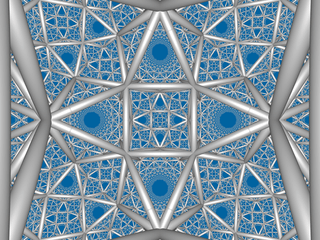 |
||||||
| {4,3,6} | t1{4,3,6} | t0,1{4,3,6} | t0,2{4,3,6} | t1,2{4,3,6} | t0,1,2{4,3,6} | t0,1,3{4,3,6} | t0,1,2,3{4,3,6} |
| Space | Euclidean 4-space | Euclidean 3-space | Hyperbolic 3-space | ||
|---|---|---|---|---|---|
| Name | {3,3,4} {3,31,1} =  |
{4,3,4} {4,31,1} =  |
{5,3,4} {5,31,1} =  |
{6,3,4} {6,31,1} =  | |
| Coxeter diagram |
|||||
| Image | 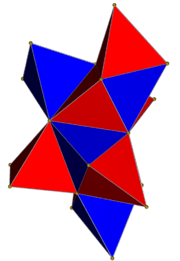 |
 |
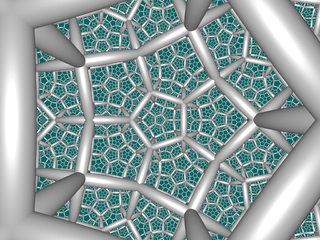 |
 | |
| Cells {p,3} |
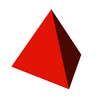 |
 |
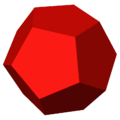 |
 | |
It has a related alternation honeycomb, represented by ![]()
![]()
![]()
![]()
![]()
![]()
![]() ↔
↔ ![]()
![]()
![]()
![]()
![]() , having triangular tiling and octahedron cells.
, having triangular tiling and octahedron cells.
It is a part of sequence of regular honeycombs with hexagonal tiling cells of the form {6,3,p}:
| Space | H3 | ||||||
|---|---|---|---|---|---|---|---|
| Form | Paracompact | Noncompact | |||||
| Name | {6,3,3} | {6,3,4} | {6,3,5} | {6,3,6} | {6,3,7} |
{6,3,8} |
... {6,3,∞} |
| Coxeter |
|||||||
| Image |  |
 |
 |
 |
 |
 | |
| Vertex figure {3,p} |
{3,3} |
{3,4} |
{3,5} |
{3,6} |
{3,7} |
{3,8} |
{3,∞} |
This honeycomb is also related to the 16-cell, cubic honeycomb and order-4 dodecahedral honeycomb all which have octahedral vertex figures.
| Space | S3 | E3 | H3 | ||||
|---|---|---|---|---|---|---|---|
| Form | Finite | Affine | Compact | Paracompact | Noncompact | ||
| Name | {3,3,4} |
{4,3,4} |
{5,3,4} |
{6,3,4} |
{7,3,4} |
{8,3,4} |
... {∞,3,4} |
| Image |  |
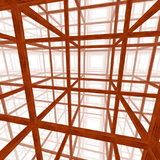 |
 |
 |
|||
| Cells | {3,3} |
{4,3} |
{5,3} |
{6,3} |
{7,3} |
{8,3} |
{∞,3} |
Rectified order-4 hexagonal tiling honeycomb
| Rectified order-4 hexagonal tiling honeycomb | |
|---|---|
| Type | Paracompact uniform honeycomb |
| Schläfli symbols | r{6,3,4} or t1{6,3,4} |
| Coxeter diagrams | |
| Cells | {3,4}  r{6,3} 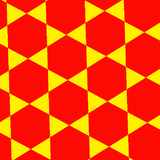 |
| Faces | Triangle {3} Hexagon {6} |
| Vertex figure |  Square prism {}×{4} |
| Coxeter groups | BV3, [6,3,4] DV3, [6,31,1] [4,3[3]] [3[ ]×[3]] |
| Properties | Vertex-transitive, edge-transitive |
The rectified order-4 hexagonal tiling honeycomb, t1{6,3,4}, ![]()
![]()
![]()
![]()
![]()
![]()
![]() has octahedral and trihexagonal tiling facets, with a square prism vertex figure.
has octahedral and trihexagonal tiling facets, with a square prism vertex figure.

It is similar to the 2D hyperbolic tetraapeirogonal tiling, r{∞,4}, ![]()
![]()
![]()
![]()
![]() which alternates apeirogonal and square faces:
which alternates apeirogonal and square faces:
Truncated order-4 hexagonal tiling honeycomb
| Truncated order-4 hexagonal tiling honeycomb | |
|---|---|
| Type | Paracompact uniform honeycomb |
| Schläfli symbol | t{6,3,4} or t0,1{6,3,4} |
| Coxeter diagram | |
| Cells | {3,4} t{6,3} |
| Faces | Triangle {3} Dodecagon {12} |
| Vertex figure |  square pyramid |
| Coxeter groups | BV3, [6,3,4] DV3, [6,31,1] |
| Properties | Vertex-transitive |
The truncated order-4 hexagonal tiling honeycomb, t0,1{6,3,4}, ![]()
![]()
![]()
![]()
![]()
![]()
![]() has octahedron and truncated hexagonal tiling facets, with a square pyramid vertex figure.
has octahedron and truncated hexagonal tiling facets, with a square pyramid vertex figure.
It is similar to the 2D hyperbolic truncated order-4 apeirogonal tiling, t{∞,4}, ![]()
![]()
![]()
![]()
![]() with apeirogonal and square faces:
with apeirogonal and square faces:
Bitruncated order-4 hexagonal tiling honeycomb
| Bitruncated order-4 hexagonal tiling honeycomb | |
|---|---|
| Type | Paracompact uniform honeycomb |
| Schläfli symbol | 2t{6,3,4} or t1,2{6,3,4} |
| Coxeter diagram | |
| Cells | t{4,3} t{3,6} t{3,6} |
| Faces | Triangle {3} hexagon {6} octagon {8} |
| Vertex figure |  tetrahedron |
| Coxeter groups | BV3, [6,3,4] DV3, [6,31,1] [4,3[3]] [3[ ]×[3]] |
| Properties | Vertex-transitive |
The bitruncated order-4 hexagonal tiling honeycomb, t1,2{6,3,4}, ![]()
![]()
![]()
![]()
![]()
![]()
![]() has Truncated octahedron and hexagonal tiling cells, with a tetrahedral vertex figure.
has Truncated octahedron and hexagonal tiling cells, with a tetrahedral vertex figure.
Cantellated order-4 hexagonal tiling honeycomb
| Cantellated order-4 hexagonal tiling honeycomb | |
|---|---|
| Type | Paracompact uniform honeycomb |
| Schläfli symbol | rr{6,3,4} or t0,2{6,3,4} |
| Coxeter diagram | |
| Cells | r{3,4} rr{6,3} |
| Faces | Triangle {3} square {4} hexagon {6} |
| Vertex figure |  triangular prism |
| Coxeter groups | BV3, [6,3,4] DV3, [6,31,1] |
| Properties | Vertex-transitive |
The cantellated order-4 hexagonal tiling honeycomb, t0,2{6,3,4}, ![]()
![]()
![]()
![]()
![]()
![]()
![]() has cuboctahedron and rhombitrihexagonal tiling cells, with a triangular prism vertex figure.
has cuboctahedron and rhombitrihexagonal tiling cells, with a triangular prism vertex figure.
Runcinated order-4 hexagonal tiling honeycomb
| Runcinated order-4 hexagonal tiling honeycomb | |
|---|---|
| Type | Paracompact uniform honeycomb |
| Schläfli symbol | t0,3{6,3,4} |
| Coxeter diagram | |
| Cells | {4,3} {6,3} {}x{6} |
| Faces | Triangle {3} square {4} hexagon {6} |
| Vertex figure |  triangular antiprism |
| Coxeter groups | BV3, [6,3,4] DV3, [6,31,1] |
| Properties | Vertex-transitive |
The runcinated order-4 hexagonal tiling honeycomb, t0,3{6,3,4}, ![]()
![]()
![]()
![]()
![]()
![]()
![]() has cube, hexagonal tiling and hexagonal prism cells, with a triangular antiprism vertex figure.
has cube, hexagonal tiling and hexagonal prism cells, with a triangular antiprism vertex figure.
It contains the 2D hyperbolic rhombitetrahexagonal tiling, rr{4,6}, ![]()
![]()
![]()
![]()
![]() with square and hexagonal faces. It also has a half symmetry construction
with square and hexagonal faces. It also has a half symmetry construction ![]()
![]()
![]() .
.
 |
 |
Omnitruncated order-4 hexagonal tiling honeycomb
| Omnitruncated order-4 hexagonal tiling honeycomb | |
|---|---|
| Type | Paracompact uniform honeycomb |
| Schläfli symbol | t0,1,2,3{6,3,4} |
| Coxeter diagram | |
| Cells | tr{4,3} tr{6,3} {}x{6} {4,3} |
| Faces | square {4} hexagon {6} dodecagon {12} |
| Vertex figure |  tetrahedron |
| Coxeter groups | BV3, [6,3,4] |
| Properties | Vertex-transitive |
The omnitruncated order-4 hexagonal tiling honeycomb, t0,1,2,3{6,3,4}, ![]()
![]()
![]()
![]()
![]()
![]()
![]() has truncated cuboctahedron, truncated trihexagonal tiling, hexagonal prism, and cube cells, with a tetrahedron vertex figure.
has truncated cuboctahedron, truncated trihexagonal tiling, hexagonal prism, and cube cells, with a tetrahedron vertex figure.
Alternated order-4 hexagonal tiling honeycomb
| Alternated order-4 hexagonal tiling honeycomb | |
|---|---|
| Type | Paracompact uniform honeycomb |
| Schläfli symbols | h{6,3,4} |
| Coxeter diagrams | |
| Cells | |
| Faces | Triangle {3} Hexagon {6} |
| Vertex figure | truncated octahedron |
| Coxeter groups | BV3, [6,3,4] |
| Properties | Vertex-transitive, edge-transitive |
Quarter order-4 hexagonal tiling honeycomb
| Quarter order-4 hexagonal tiling honeycomb | |
|---|---|
| Type | Paracompact uniform honeycomb |
| Schläfli symbol | q{6,3,4} |
| Coxeter diagram | |
| Cells | {3,6} {3,3} t{3,3} rr{3,6} |
| Faces | {3}, {6} |
| Vertex figure |  Triangular cupola |
| Coxeter groups |  , [3[ ]x[ ]] , [3[ ]x[ ]] |
| Properties | Vertex-transitive |
The quarter order-4 hexagonal tiling honeycomb, q{6,3,4}, ![]()
![]()
![]()
![]()
![]()
![]()
![]() or
or ![]()
![]()
![]()
![]()
![]() with a triangular cupola vertex figure.
with a triangular cupola vertex figure.
See also
- Convex uniform honeycombs in hyperbolic space
- List of regular polytopes
References
- ↑ Coxeter The Beauty of Geometry, 1999, Chapter 10, Table III
- Coxeter, Regular Polytopes, 3rd. ed., Dover Publications, 1973. ISBN 0-486-61480-8. (Tables I and II: Regular polytopes and honeycombs, pp. 294–296)
- The Beauty of Geometry: Twelve Essays (1999), Dover Publications, LCCN 99-35678, ISBN 0-486-40919-8 (Chapter 10, Regular Honeycombs in Hyperbolic Space) Table III
- Jeffrey R. Weeks The Shape of Space, 2nd edition ISBN 0-8247-0709-5 (Chapter 16-17: Geometries on Three-manifolds I,II)
- Norman Johnson Uniform Polytopes, Manuscript
- N.W. Johnson: The Theory of Uniform Polytopes and Honeycombs, Ph.D. Dissertation, University of Toronto, 1966
- N.W. Johnson: Geometries and Transformations, (2015) Chapter 13: Hyperbolic Coxeter groups


